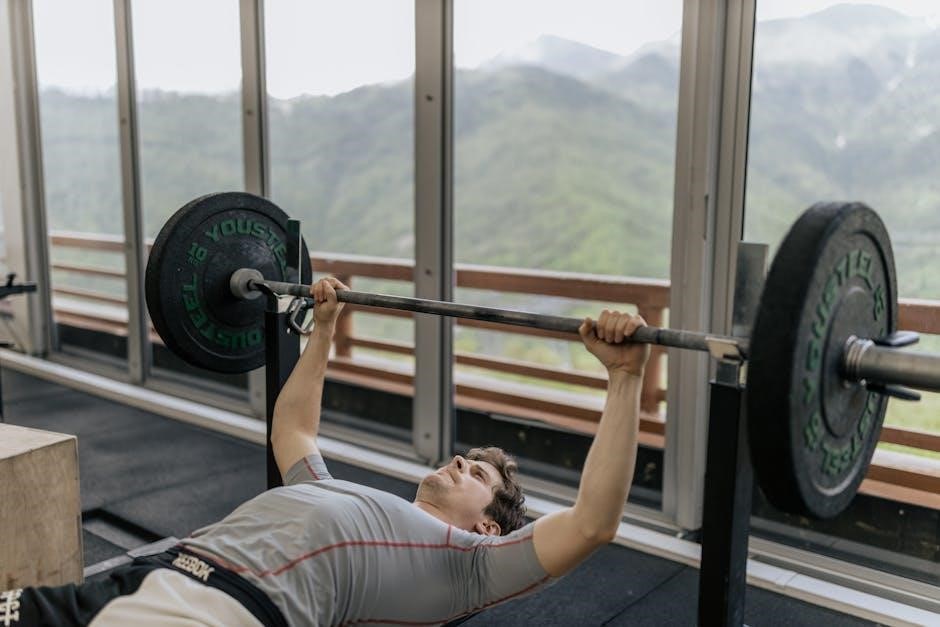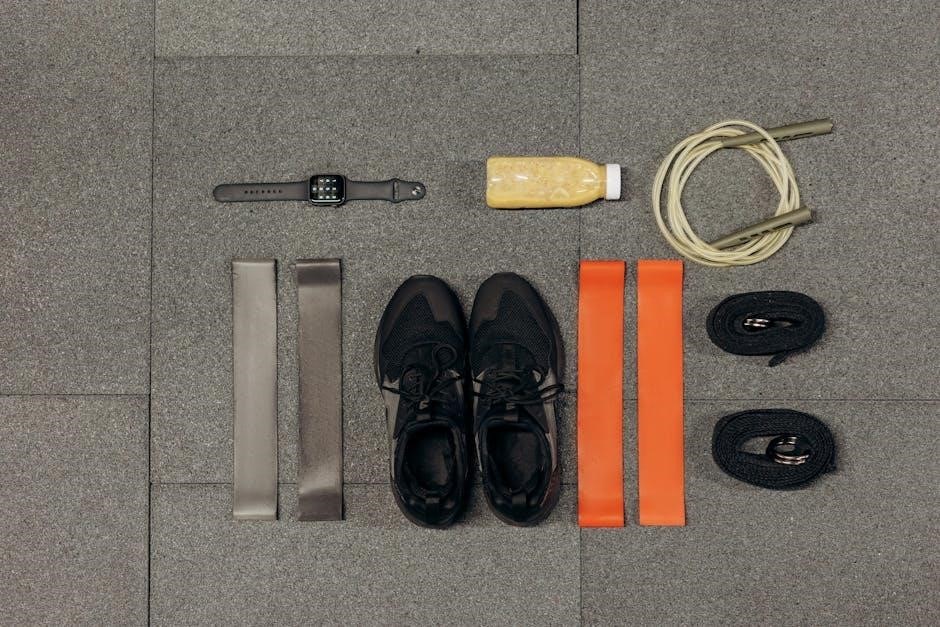The GLA:D program is a standardized, individualized approach for managing hip and knee osteoarthritis, combining education and exercise therapy led by trained physiotherapists. It focuses on improving joint function through neuromuscular exercises, promoting symptom relief and enhanced quality of life. The program is evidence-based, cost-effective, and widely accessible, making it a popular choice for those seeking non-surgical solutions.
Overview of the GLA:D Program
The GLA:D program is a structured, evidence-based approach designed to manage hip and knee osteoarthritis through education and exercise. It consists of two educational sessions and 12 group exercise sessions over six weeks, led by trained physiotherapists. The program focuses on improving joint function, reducing pain, and enhancing quality of life. Exercises are tailored to individual needs, emphasizing neuromuscular control and progressive strengthening. The program is standardized yet adaptable, ensuring a personalized experience for participants. Its goal is to empower individuals with osteoarthritis to manage their symptoms effectively and maintain long-term functional ability.
Purpose and Target Audience
The GLA:D program aims to provide guideline-based education and exercise therapy for individuals with hip or knee osteoarthritis, focusing on improving joint function and reducing pain. It targets those seeking non-surgical management, particularly individuals with mild to moderate osteoarthritis. The program is designed for adults looking to enhance their mobility, strength, and quality of life through structured, evidence-based interventions. Physiotherapists deliver the program, ensuring personalized care and adherence to therapeutic guidelines, making it accessible and effective for a wide range of participants.

Understanding the GLA:D Program
The GLA:D program combines education and exercise to manage hip and knee osteoarthritis, focusing on improving function and reducing pain through tailored, evidence-based interventions.
What is the GLA:D Program?
The GLA:D program is an evidence-based exercise and education intervention designed for individuals with hip or knee osteoarthritis. It focuses on improving joint function, reducing pain, and enhancing quality of life through tailored neuromuscular exercises. The program emphasizes patient education, movement retraining, and progressive exercises to address physical limitations. Participants receive personalized guidance and a structured plan, often supported by a downloadable PDF guide. This resource outlines exercises, progression strategies, and monitoring techniques to ensure safe and effective implementation. The program aims to empower individuals to manage their condition actively and sustainably.
Core Components and Structure
The GLA:D program is built on two main components: education and exercise. Educational sessions focus on understanding osteoarthritis, managing symptoms, and improving daily activities. Exercise sessions emphasize neuromuscular training, strength, and functional stability. The program is structured in a progressive manner, with exercises tailored to individual needs. A PDF guide is often provided, detailing the exercises, progression, and monitoring strategies. This structured approach ensures participants can safely and effectively manage their condition, promoting long-term joint health and functional ability. The program’s design allows for flexibility, catering to diverse fitness levels and goals.
Benefits of the GLA:D Program
The GLA:D program offers significant benefits for individuals with hip or knee osteoarthritis. It reduces pain, improves joint function, and enhances overall mobility. Participants often experience better balance and reduced risk of falls. The program is cost-effective, avoiding the need for surgery or medication. It promotes long-term management of symptoms and improves quality of life. The structured approach ensures sustainable results, making it a highly recommended option for those seeking non-invasive, evidence-based care. Its focus on education and exercise empowers individuals to take control of their joint health effectively.
Structure of the GLA:D Program
The GLA:D program is structured into educational and exercise sessions. It combines theoretical knowledge with practical exercises, tailored to individual needs, ensuring progressive improvement and sustainability;
Educational Sessions
The GLA:D program includes educational sessions designed to empower participants with knowledge about osteoarthritis, pain management, and lifestyle modifications. These sessions, led by healthcare professionals, focus on understanding symptoms, setting realistic goals, and adopting healthy habits. Topics include proper posture, nutrition, and stress reduction, alongside exercises tailored to improve joint health. The educational component complements the physical exercises, ensuring participants gain a holistic understanding of their condition. This combination of education and movement aims to enhance symptom relief, improve function, and boost confidence in managing daily activities. The program emphasizes sustainable, long-term benefits, supported by evidence-based practices.
Exercise Sessions
The GLA:D program’s exercise sessions focus on improving joint stability, strength, and flexibility through evidence-based, neuromuscular training. Supervised by trained professionals, these sessions include exercises tailored to individual needs, emphasizing proper movement patterns. Participants engage in group or individualized exercises designed to enhance functional abilities and reduce pain. The program progressively increases difficulty to promote continuous improvement. Regular attendance is encouraged to maximize benefits, with exercises aimed at improving mobility, balance, and overall joint health. This structured approach ensures a safe and effective path toward better physical function and symptom management.
Progression and Tailoring
The GLA:D program incorporates a structured progression system, ensuring exercises evolve with the participant’s improvement. Each session is tailored to individual needs, with adjustments made based on performance and feedback; Trained professionals assess progress and modify exercises to maintain challenge and prevent plateaus. The program emphasizes gradual increases in intensity and complexity to promote sustainable improvement. This personalized approach, supported by the GLA:D program PDF guide, ensures that participants receive optimal benefits while minimizing the risk of overexertion or injury. Regular assessments guide the progression, keeping the program dynamic and effective.

GLA:D Program Exercises
The GLA:D program features evidence-based exercises targeting hip and knee function, focusing on strength, stability, and movement patterns. The exercises are structured to improve mobility and reduce pain, with variations to suit different fitness levels. The program’s exercise regimen is detailed in the GLA:D program PDF guide, providing clear instructions and visual aids for proper execution. This comprehensive approach ensures participants can perform exercises safely and effectively, both in clinical settings and at home.
Overview of Exercises
The GLA:D program exercises are specifically designed to address hip and knee osteoarthritis, focusing on improving strength, stability, and functional movement patterns. The exercises are evidence-based and structured to promote joint health while reducing pain and improving mobility. The program incorporates a variety of activities, including neuromuscular training, strengthening exercises, and daily functional tasks. These exercises are detailed in the GLA:D program PDF guide, which provides step-by-step instructions and visual aids to ensure proper form and technique. The exercises are adaptable to different fitness levels, making them accessible for a wide range of participants.
Specific Exercises for Hip and Knee
The GLA:D program includes targeted exercises for the hip and knee to enhance joint function and reduce osteoarthritis symptoms. Key exercises include bridging, clamshells, and step-ups, which strengthen the muscles around the hips and knees. These movements improve stability, balance, and mobility. The program also incorporates functional exercises like squats and lunges to mimic daily activities. All exercises are low-impact and tailored to individual capabilities, ensuring safe progression. The GLA:D program PDF guide provides detailed descriptions and visuals to help participants perform these exercises correctly and effectively.
Exercise Modification and Difficulty Levels
The GLA:D program offers scalable exercises with modifications to suit individual needs and progress levels. Participants can adjust difficulty by changing repetitions, resistance, or range of motion. For example, exercises like squats can be modified to chair-assisted or wall slides for those with limited mobility. The program emphasizes gradual progression, allowing individuals to build strength and confidence over time. Providers are trained to tailor exercises, ensuring each participant works within a safe and challenging range while maintaining proper technique and alignment.

Benefits of the GLA:D Program
The GLA:D program reduces pain, improves joint function, and enhances quality of life for individuals with hip or knee osteoarthritis, promoting long-term mobility and independence.
Symptom Relief and Improved Function
The GLA:D program emphasizes exercises tailored to alleviate osteoarthritis symptoms, such as pain and stiffness, while enhancing joint mobility and functional abilities. By focusing on neuromuscular training, participants experience significant improvements in daily activities like walking and climbing stairs. The structured approach ensures sustainable relief, allowing individuals to maintain independence and reduce reliance on pain medication. Improved function is achieved through targeted exercises that strengthen muscles and improve joint stability, making everyday tasks easier and less discomforting.
Functional Improvements
The GLA:D program is designed to enhance physical function in individuals with osteoarthritis, focusing on improving mobility, balance, and coordination. Participants often experience better performance in daily activities such as walking, climbing stairs, and maintaining balance. The program’s exercises strengthen lower limb muscles and improve joint stability, leading to greater confidence and independence. Clinical trials have shown measurable improvements in functional outcomes, reducing the risk of falls and enhancing overall quality of life.
Cost-Effectiveness and Accessibility
The GLA:D program is a cost-effective solution for managing osteoarthritis, offering standardized exercises that can be delivered in group settings, reducing individual costs. Its accessibility is enhanced through availability in clinical and community centers, ensuring widespread reach; The program’s structured approach minimizes the need for expensive equipment, making it affordable for diverse populations. Additionally, the GLA:D program PDF guide provides participants with accessible resources, further reducing barriers to participation and ensuring equitable access to high-quality care.

Testimonials and Success Stories
Participants often report significant improvements in mobility and pain reduction, highlighting the program’s effectiveness. Many share inspiring stories of regaining independence and enjoying daily activities;
Participant Testimonials
Participants in the GLA:D program often praise its structured approach and effectiveness; Many report reduced pain, improved mobility, and enhanced quality of life. One participant shared, “The exercises were tailored to my needs, and the progression was gradual, which made it sustainable.” Others highlight the educational component, stating it helped them understand their condition better. The program’s focus on functional movements has enabled many to return to activities they thought were lost to them.
The availability of the GLA:D program exercises PDF has also been a key factor in participant satisfaction, providing a clear and accessible guide for home practice.
Success Stories and Outcomes
The GLA:D program has yielded remarkable success stories, with many participants achieving significant reductions in pain and improvements in physical function. A majority report enhanced mobility, enabling them to perform daily activities with greater ease. The structured exercise regimen, supported by the GLA:D program exercises PDF, has been instrumental in these outcomes. Participants often highlight the program’s ability to empower them with knowledge and tools for long-term management of their conditions, leading to improved overall well-being.
These positive outcomes underscore the program’s effectiveness in fostering sustainable health benefits.

Getting Started with the GLA:D Program
Getting started with the GLA:D program involves finding a certified provider, reviewing eligibility criteria, and preparing with the GLA:D program exercises PDF guide.
How to Find a GLA:D Provider
To find a GLA:D provider, visit the official GLA:D program website and use their provider locator tool. Enter your location to find certified clinics or therapists in your area. Ensure the provider is accredited and experienced in delivering the GLA:D program. Additionally, contact local orthopedic clinics or physical therapy centers, as they often offer the program. You can also download the GLA:D program exercises PDF guide for more details on finding a provider near you.
Eligibility Criteria
The GLA:D program is designed for individuals experiencing hip or knee pain, particularly those with early signs of osteoarthritis. Eligibility criteria include being at least 18 years old and having symptoms such as pain or limited function in the affected joint. Participants should be able to perform basic exercises and attend twice-weekly sessions. A referral from a healthcare provider is typically required. Providers assess suitability during an initial consultation to ensure the program aligns with the individual’s needs and abilities. This ensures a safe and effective participation in the GLA:D program exercises.
Preparation for the Program
Preparation for the GLA:D program involves several key steps to ensure a smooth and effective experience. Participants should first consult with their healthcare provider to confirm suitability. Attending an initial assessment with a certified GLA:D provider is essential to discuss goals and any physical limitations. Comfortable clothing and footwear for exercise are recommended. Participants should also review the provided materials, including the GLA:D program exercises PDF, to familiarize themselves with the routines. Staying hydrated and bringing necessary items like a yoga mat or water bottle is also advised. Proper preparation enhances engagement and outcomes in the program.

GLA:D Program PDF Guide
The GLA:D program PDF guide provides comprehensive resources for participants, including detailed exercise routines, educational materials, and progress tracking tools to support program adherence and success.
Overview of the PDF Guide
The GLA:D program exercises PDF guide is a comprehensive resource designed to support participants in understanding and performing the program’s exercises effectively. It includes detailed descriptions, illustrations, and step-by-step instructions for each exercise, ensuring proper form and technique. The guide also covers educational content about osteoarthritis, symptom management, and lifestyle tips to enhance overall well-being. By providing clear and accessible information, the PDF guide empowers participants to take an active role in their treatment and rehabilitation journey, aligning with the program’s evidence-based approach to improving joint health and function.
How to Access the PDF
To access the GLA:D program exercises PDF, visit the official GLA:D website and navigate to the “Resources” or “Downloads” section. Locate the “GLA:D Program Exercises PDF” option and download it directly. If prompted, create an account to access the download. Ensure you only download from the official site to maintain safety and authenticity. Additionally, consider checking with healthcare providers or using an official mobile app for convenient access to the exercise guide.
Key Features of the Guide
The GLA:D program exercises PDF guide offers a comprehensive overview of the program’s structured approach. It includes detailed descriptions of exercises tailored for hip and knee osteoarthritis, along with step-by-step instructions and visual aids. The guide emphasizes neuromuscular training, focusing on strength, balance, and functional movements. It also provides progression plans to adapt exercises based on individual improvement. Additionally, it includes tips for maintaining motivation and adhering to the program. This resource is designed to be user-friendly, ensuring participants can follow the exercises safely and effectively, whether at home or in a clinical setting.

Science Behind the GLA:D Program
The GLA:D program is rooted in a neuromuscular exercise approach, supported by clinical trials showing significant pain reduction and functional improvement in participants with osteoarthritis.
Neuromuscular Exercise Approach
The GLA:D program employs a neuromuscular exercise approach, focusing on improving muscle strength, balance, and coordination to enhance joint stability and function. This evidence-based method targets the activation of specific muscle groups, promoting proper movement patterns and reducing pain. The exercises are tailored to individual needs, ensuring progressive overload to maintain effectiveness. By addressing neuromuscular deficits, participants achieve better functional outcomes, particularly in managing osteoarthritis. The approach emphasizes safety, adaptability, and long-term sustainability, making it a cornerstone of the GLA:D program’s success.
Evidence Supporting the Program
The GLA:D program is backed by robust clinical evidence demonstrating its effectiveness in managing osteoarthritis. Studies have shown significant reductions in pain and improvements in functional abilities among participants. The program’s structured approach, combining education and exercise, has been proven to enhance quality of life and reduce healthcare utilization. Research highlights its cost-effectiveness and long-term sustainability. International recognition and endorsement by health organizations further validate its evidence-based foundation, making it a trusted option for individuals with hip and knee osteoarthritis.
Continuous Updates and Research
The GLA:D program is continuously updated based on the latest research to ensure optimal outcomes. Ongoing studies refine exercise protocols and educational content, reflecting advancements in osteoarthritis management. Regular reviews of clinical data help improve the program’s effectiveness and safety. This commitment to evidence-based evolution ensures the program remains at the forefront of conservative care for hip and knee conditions, providing participants with the most current and effective strategies for managing their symptoms and improving function.
Comparing GLA:D with Other Programs
The GLA:D program stands out with its structured, evidence-based approach to exercise and education, tailored for osteoarthritis, unlike generic fitness programs or other rehabilitation plans.
Alternative Programs
Other programs, like general fitness classes or yoga, may offer benefits for joint health but lack the targeted, evidence-based approach of GLA:D. These alternatives often focus broadly on strength or flexibility without addressing osteoarthritis-specific needs. In contrast, GLA:D’s structured exercises and educational components provide a comprehensive approach tailored to hip and knee conditions. While alternative programs can complement GLA:D, they may not offer the same level of progression or personalized care, making GLA:D a unique and effective choice for managing osteoarthritis symptoms.
Unique Aspects of GLA:D
The GLA:D program stands out for its evidence-based, neuromuscular exercise approach, specifically designed for hip and knee osteoarthritis. It combines tailored exercises with education, focusing on movement quality and functional improvements. Unlike other programs, GLA:D emphasizes individualized progression, ensuring exercises are adapted to each participant’s and goals. The program’s structured yet flexible design, along with its focus on long-term symptom management, makes it a unique and effective option for those seeking sustainable relief from osteoarthritis symptoms.

Real-World Applications
The GLA:D program is widely implemented in clinical and community settings, offering practical exercises for hip and knee osteoarthritis management. Its structured approach supports both in-person and remote delivery, ensuring accessibility for diverse populations.
Case Studies
Case studies highlight the effectiveness of the GLA:D program exercises in real-life scenarios. Participants with knee or hip osteoarthritis have demonstrated significant improvements in function and pain reduction. Specific examples include individuals who achieved enhanced mobility and reduced symptoms by following the structured exercise approach. These studies emphasize the program’s focus on neuromuscular training and tailored exercises, proving its adaptability to diverse patient needs. The outcomes underscore the program’s ability to improve quality of life, whether delivered in clinical or home-based settings, with guidance from qualified healthcare professionals.
Clinical and Home Settings
The GLA:D program can be effectively implemented in both clinical and home settings, offering flexibility for participants. In clinical environments, exercises are typically supervised by healthcare professionals, ensuring proper form and adherence to the program. This supervision can enhance effectiveness and outcomes. At home, individuals use resources like the GLA:D program exercises PDF to guide their practice, providing convenience and autonomy. While home settings require self-discipline, they offer flexibility. Both environments utilize the PDF as a key resource, with clinical settings benefiting from professional guidance and home settings relying on personal motivation and correct form adherence.
Remote Delivery Options
The GLA:D program offers remote delivery options, enhancing accessibility for participants with limited mobility or preferring home-based engagement. Virtual sessions, such as telehealth appointments, allow healthcare providers to guide individuals through exercises and provide real-time feedback. The GLA:D program exercises PDF serves as a valuable resource, enabling participants to follow structured routines independently. Remote delivery ensures continuity of care and encourages adherence to the program, making it ideal for those who cannot attend in-person sessions. This flexibility promotes widespread accessibility and supports consistent progress in managing hip and knee conditions effectively.

Safety and Precautions
The GLA:D program emphasizes safety through proper warm-up, correct technique, and tailored exercises to individual capabilities, ensuring injury prevention and effective progression under professional guidance.
Safety Measures
The GLA:D program prioritizes safety by ensuring participants receive proper screening and assessment before starting exercises. Supervised sessions with certified professionals minimize injury risks, and participants are guided to avoid movements that exacerbate pain. Emphasis is placed on using pain as a guide, with exercises adjusted to individual tolerance levels. Clear instructions and demonstrations ensure correct technique, reducing the likelihood of improper form. Additionally, the program encourages open communication between participants and providers to address concerns promptly and safely.
Contraindications
The GLA:D program may not be suitable for individuals with severe joint instability, acute fractures, or recent surgeries. Those with significant pain that limits movement or moderate-to-severe osteoarthritis requiring joint replacement should consult their healthcare provider. Additionally, individuals with chronic conditions like severe rheumatoid arthritis or those with acute inflammatory joint diseases may need to avoid certain exercises. It is essential to assess each participant’s medical history and current condition to ensure safe participation and avoid potential complications during the program.
Monitoring and Adjustments
Regular monitoring is essential to ensure participant safety and program effectiveness. Instructors assess progress, pain levels, and functional improvements throughout the GLA:D program. Adjustments are made to exercise intensity, technique, or difficulty based on individual responses. Healthcare providers may modify the program for specific needs or if symptoms worsen. Ongoing feedback helps tailor the approach, ensuring exercises remain safe and beneficial. This adaptive process supports optimal outcomes and minimizes risks, making the program suitable for diverse participant requirements and promoting long-term joint health.
The GLA:D program effectively combines education and exercise, offering tailored approaches to alleviate osteoarthritis symptoms and improve joint function, encouraging active participation for better long-term outcomes.
The GLA:D program is an evidence-based approach for managing hip and knee osteoarthritis, combining education and tailored exercises to improve joint function and reduce pain. It emphasizes neuromuscular training, focusing on strength, balance, and movement quality. The program is structured to progress gradually, ensuring exercises are adapted to individual needs. By addressing the root causes of symptoms, GLA:D helps participants regain independence and improve their quality of life. The program’s structured yet flexible design makes it accessible and effective for a wide range of individuals.
Final Thoughts and Encouragement
The GLA:D program offers a transformative approach to managing osteoarthritis, empowering individuals to take control of their health. By combining education and tailored exercises, participants can significantly improve their quality of life. The program’s focus on sustainable, long-term benefits makes it a valuable investment in one’s well-being. Encouraging commitment and consistency, the GLA:D program provides a supportive framework for achieving lasting results. Embrace this opportunity to enhance mobility, reduce pain, and regain confidence in your daily activities.